The overall fisheries production in Region I increased by 2.5 percent in 4th quarter 2018. From the total output of 63,428 metric tons in 4th quarter 2017, it grew to 64,989 metric tons in 4th quarter 2018. The provinces of La Union and Pangasinan posted increments in their output.

The municipal and aquaculture subsectors registered higher output in 4th quarter 2018 compared with their levels a year ago. The aquaculture contributed 83.7 percent to the total fisheries output. The municipal and commercial fisheries accounted for 15.3 percent and 1.0 percent, respectively.
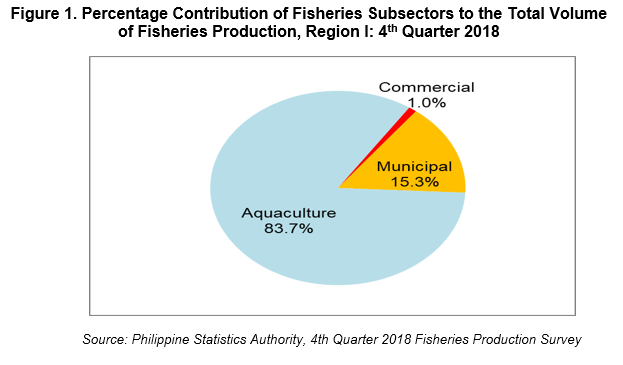
In terms of provincial distribution, the province of Pangasinan shared the bulk of production of about 92.8 percent. The overall volume of production of the province was posted at 60,327 metric tons, or 2.4 percent higher than its production in the same period of 2017. The production of its aquaculture and municipal subsectors increased by 1.1 percent and 28.1 percent respectively. Meanwhile, the commercial subsector went down by 55.4 percent.
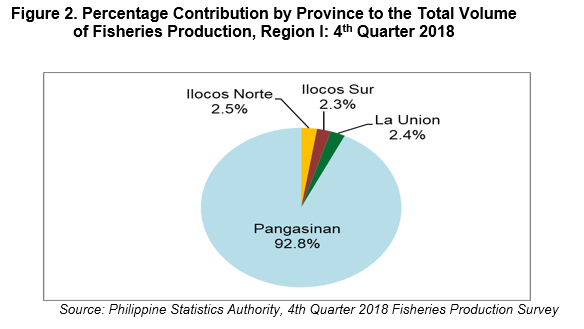
The fisheries production of Ilocos Norte went down by 14.4 percent in 4th quarter 2018. Its output was posted at 1,654 metric tons, lower than the output of 1,933 metric tons in 4th quarter 2017. The municipal subsector pulled down the overall performance of the province in terms of fisheries production.
The province of La Union registered higher fisheries production in 4th quarter 2018 compared with its level a year ago. From 1,052 metric tons production, it went up to 1,543 metric tons. The increment in the output of the municipal and aquaculture sub-sectors contributed to the overall growth.
The fisheries production of Ilocos Sur was recorded at 1,464 metric tons in 4th quarter 2018, lower than the production a year ago of 1,543 metric tons. The province had the least percent share of about 2.3 percent to the total fisheries production of Region I. The volume of production of the municipal and aquaculture subsectors in the province declined by 3.5 percent and 23.0 percent respectively.
Commercial Fisheries
The commercial fisheries volume of production in Region I was posted at 679 metric tons in 4th quarter 2018. This output was lower than the production in 4th quarter 2017 of 1,245 metric tons. The provinces of La Union and Pangasinan displayed decrement in output. There were lesser number of fishing vessels as some were dry-docked for repair. Absence of school of fish was also noted.
In terms of provincial shares, Pangasinan accounted for 63.6 percent of the region’s commercial fisheries volume of production in 4th quarter 2018. La Union followed with 28.8 percent share and Ilocos Sur with 7.6 percent share.
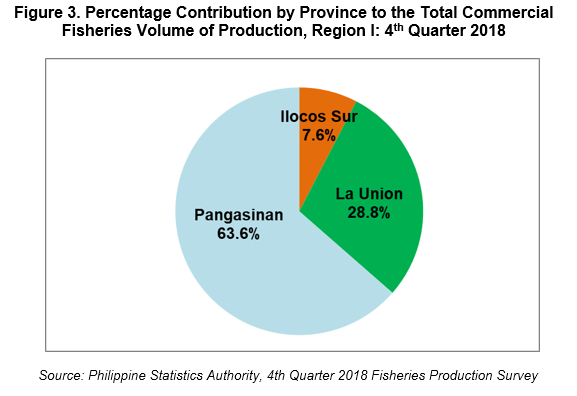
The top five major catch in the region during the 4th quarter 2018 were Skipjack, Roundscad, Threadfin bream, Hairtail and Indian mackerel.
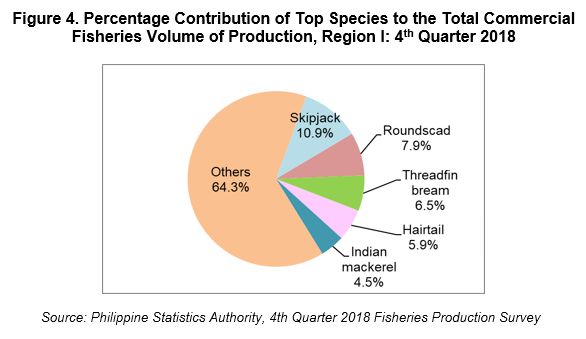
Municipal Fisheries
The overall municipal fisheries production of Region I grew by 13.5 percent in 4th quarter 2018. The production was posted at 9,933 metric tons, higher than the output in 4th quarter 2017 of 8,754 metric tons. The increased catch in both marine and inland municipal fisheries contributed to the overall positive performance of the subsector.
Marine Municipal
Production of Marine Municipal Fisheries in Region I grew by 13.8 in 4th quarter 2018. Its output was posted at 9,391 metric tons, higher than the output in 4th quarter 2017 of 8,253 metric tons. The provinces of La Union and Pangasinan contributed to the overall increment in output. More harvests from artificial reefs and presence of school of fish of bigger sizes contributed to the positive growth in production.
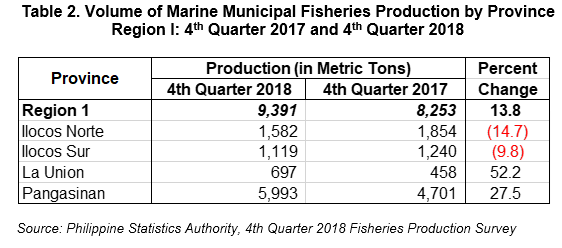
The province of Pangasinan contributed 63.8 percent to the region’s marine municipal fish catch for the 4th quarter 2018. It was followed by Ilocos Norte with 16.8 percent share, Ilocos Sur with 11.9 percent share, and La Union with 7.4 percent share.

The dominant catch in marine municipal waters of Region I during the period were Yellowfin tuna, Flying fish, Grouper, Threadfin bream, and Skipjack.
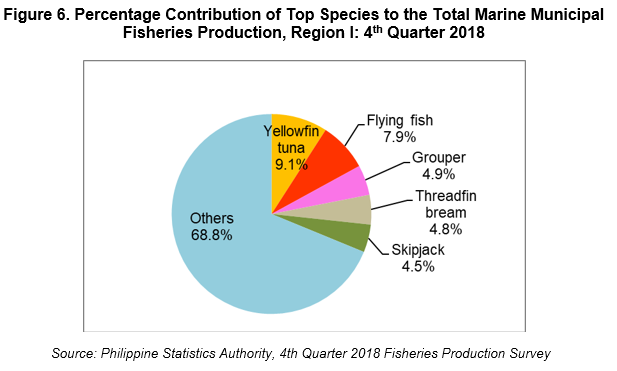
Inland Municipal Fisheries
Production of Inland Municipal Fisheries in Region I went up by 8.1 percent in 4th quarter 2018. From its output of 501 metric tons in 4th quarter 2017, it went up to 542 metric tons. The provinces of Ilocos Sur and Pangasinan posted higher output. More catch were recorded due to overflowed pens and cages during the occurrence of Typhoons Ompong and Rosita, coupled with the availability of tilapia fingerlings.
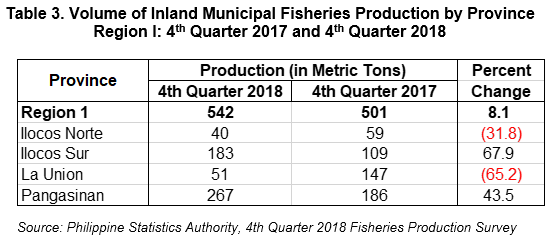
By province, Pangasinan ranked first in terms of volume of production of Inland Municipal Fisheries during the 4th quarter 2018 with 49.3 percent share. Ilocos Sur followed with 33.8 percent share, La Union with 9.4 percent share, and Ilocos Norte with 7.4 percent share.

The top five major catch in the region during the period were Tilapia, Carp, Freshwater crab, Freshwater goby, and Mullet.
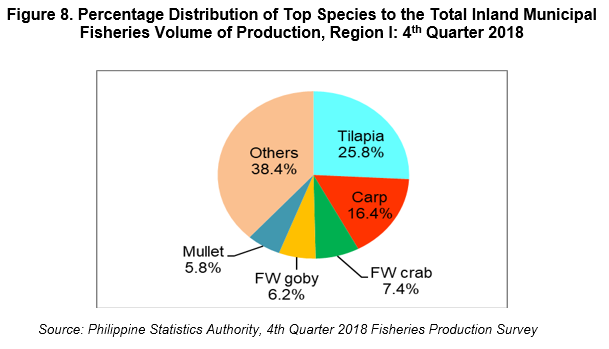
Aquaculture
Aquaculture production of Region I was posted at of 54,377 metric tons in 4th quarter 2018, higher than the output in the same period of 2017 of 53,428 metric tons. Increased stocking rate due to availability of fingerlings, higher survivability due to favorable high water level, and presence of natural food and bigger sizes of produce were the factors that contributed to the overall positive growth in output. All the provinces of the region, except Ilocos Sur, displayed higher production.
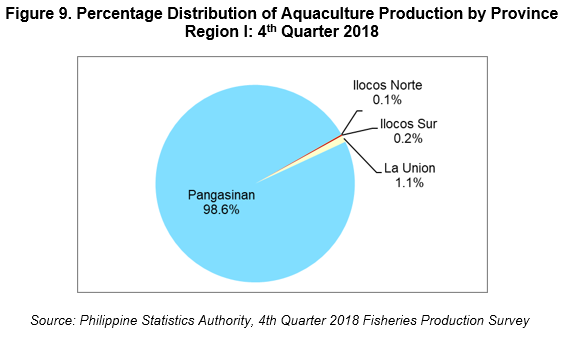
The province of Pangasinan shared the bulk of aquaculture production in 4th quarter 2018 with 98.6 percent. By culture type, aquaculture in Region I was dominated by Marine cage which accounted for 80.7 percent of the total production.

Milkfish dominated the aquaculture production of Region I with a share of 93.5 percent. Its production in 4th quarter 2018 was posted at 50,854 metric tons, higher than its output in the same quarter of 2017 of 50,199 metric tons. Increased stocking rate was noted due to availability of quality fingerlings. Forced harvesting was made in Pangasinan due to changing weather from hot to cold that may have caused fish kill.

TECHNICAL NOTES
The Fisheries Production Survey of the Philippine Statistics Authority (PSA) is divided into four major fisheries surveys. These are the Quarterly Commercial Fisheries Survey (QCFS), Quarterly Municipal Fisheries Survey (QMFS), Quarterly Inland Fisheries Survey (QIFS) and Quarterly Aquaculture Survey (QAqS). The commercial and municipal fisheries surveys aim to provide quarterly data on volume and value of fish production by species, by region, and by province. The aquaculture survey is intended to generate quarterly data on volume and value of cultured species by environment, by type of aquafarm, by region, and by province.
Concepts and Definitions:
Aquaculture – fishery operation involving all forms of raising and culturing of fish and other fishery species in marine, brackish and freshwater environment. Examples are fishponds, fish pens, fish cages, mussel, oyster, seaweed farms and hatcheries.
Aquafarm – the farming facilities used in the culture or propagation of aquatic species including fish, mollusk, crustaceans, and aquatic plants for purposes of rearing to enhance production.
Brackishwater – mixture of seawater and freshwater with salinity that varies with the tide. Example are estuaries, mangroves, and mouths of rivers where seawater enters during high tide.
Commercial Fishing – the catching of fish with the use of fishing boats with a capacity of more than three (3) gross tons for trade, business or profit beyond subsistence or sports fishing.
Fisheries – all activities relating to the act or business of fishing, culturing, preserving, processing, marketing, developing, conserving and managing aquatic resources and the fishery areas including the privilege to fish or take aquatic resources thereof (RA 8550).
Fisheries Sector – the sector engaged in the production, growing, harvesting, processing, marketing, developing, conserving and managing aquatic resources and fishing areas.
Fish Cage – stationary or floating fish enclosure made of synthetic net wire/bamboo screen or other materials set in the form of an inverted mosquito net (“hapa” type) with or without cover with all sides either tied to poles staked to the water bottom or with anchored floats for aquaculture purposes.
Fishing Gear – any instrument or device and its accessories utilized in taking fish and other fishery species.
Fishing Grounds – areas in any body of water where fish and other aquatic resources congregate and become the target of capture.
Fish Pen – an artificial enclosure constructed within a body of water for culturing fish and fishery/ aquatic resources made up of bamboo poles closely arranged in an enclosure with wooden materials, screen or nylon netting to prevent an escape of fish.
Fishpond – a body of water (artificial or natural) where fish and other aquatic products are cultured, raised or cultivated under controlled conditions. This is a land-based type of aquafarm. Note that the setting-up of fish cages in ponds does not make the operation of a fish cage and at the same time a fishpond.
Freshwater – water without salt or marine origins, such as generally found in lakes, rivers, canals, dams, reservoirs, paddy fields, and swamps.
Inland Municipal Fishing – the catching of fish, crustaceans, mollusks and all other aquatic animals and plants in inland water like lakes, rivers, dams, marshes, etc. using simple gears and fishing boats some of which are non-motorized with a capacity of three gross tons or less; or fishing not requiring the use of fishing boats.
Landing Center – a place where the fish catch and other aquatic products are unloaded and traded.
Municipal Fishing – covers fishing operation carried out with or without the use of a boat weighing three gross tons or less.
SGD. ATTY. SHEILA O. DE GUZMAN
(Chief Administrative Officer)
Officer-in-Charge

